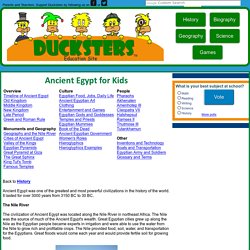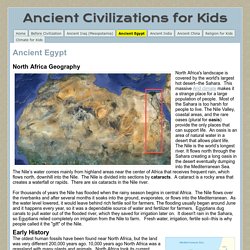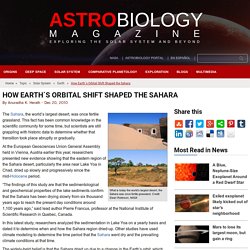

Discover Ancient Egypt. Egyptianmap stamp. History: Egyptians. Ancient Egypt Facts For Kids, Nile River, Gods, Maps and Pyramids. Ic.galegroup. Kids History: Ancient Egypt for Kids. Back to History Ancient Egypt was one of the greatest and most powerful civilizations in the history of the world.

It lasted for over 3000 years from 3150 BC to 30 BC. The Nile River The civilization of Ancient Egypt was located along the Nile River in northeast Africa. The Nile was the source of much of the Ancient Egypt's wealth. Pyramids of Giza by Ricardo Liberato Kingdoms and Periods Historians usually group the history of Ancient Egypt into three major kingdoms called the Old Kingdom, the Middle Kingdom, and the New Kingdom. Culture Ancient Egypt was rich in culture including government, religion, arts, and writing. Pyramids and Treasure The Pharaohs of Egypt were often buried in giant pyramids or in secret tombs. End of the Empire The Ancient Egyptian Empire began to weaken in about 700 BC. Fun Facts about Ancient Egypt Egyptian men and women wore makeup.
Take a ten question quiz about this page. Go here to test your knowledge with a Ancient Egypt crossword puzzle or word search. Ancient Egypt for Kids and Teachers - Ancient Egypt for Kids. Daily Life in Ancient Egypt. The daily life in ancient Egypt was actually much different than the vision that commonly comes to mind.

Relics found in archaeological digs as well as paintings and drawings on pyramid and tomb walls depict images of life in ancient Egypt that was, in some regards, not that much different than life in Egypt today. Family Life Family was important in ancient Egypt, and family life began early for the ancient Egyptians. Men and women both tended to marry young, and most marriages were polygamous with the husband having several wives. The husband usually had a senior or chief wife who was considered higher than the other ones. Children Children were also an important part of the family unit. . © Jean-Pierre Dalbéra - Relief of Akhenaten and his family Working Life Peasant life in ancient Egypt was not always enjoyable. The Egyptians were one of the first people to introduce the use of the ox-drawn plow; however the work of plowing, planting and harvesting would have still been very difficult. Ancient Egypt - Ancient Civilizations for Kids.
North Africa Geography North Africa's landscape is covered by the world's largest hot desert--the Sahara.

This massive Arid climate makes it a strange place for a large population of people. Most of the Sahara is too harsh for people to live. The Nile Valley, coastal areas, and the rare oases (plural for oasis) provide the only places that can support life. An oasis is an area of natural water in a desert that allows plant life. For thousands of years the Nile has flooded when the rainy season begins in central Africa.
Early History The oldest human fossils have been found near North Africa, but the land was very different 200,000 years ago. 10,000 years ago North Africa was a grassland with many plants and animals. Egyptian Civilization Starting around 5500 BCE two major kingdoms developed along the Nile. Religion was a the center of Egyptian life. Egyptians were a very advanced civilization due to their inventions and technology. Ancient Egypt's History. Ancient Egypt Online. How Earth´s Orbital Shift Shaped the Sahara. The Sahara, the world’s largest desert, was once fertile grassland.

This fact has been common knowledge in the scientific community for some time, but scientists are still grappling with historic data to determine whether that transition took place abruptly or gradually. At the European Geosciences Union General Assembly held in Vienna, Austria earlier this year, researchers presented new evidence showing that the eastern region of the Sahara desert, particularly the area near Lake Yoa in Chad, dried up slowly and progressively since the mid-Holocene period. “The findings of this study are that the sedimentological and geochemical properties of the lake sediments confirm that the Sahara has been drying slowly from six thousand years ago to reach the present day conditions around 1,100 years ago,” said lead author Pierre Francus, professor at the National Institute of Scientific Research in Quebec, Canada.
Technology. Leaders and Government. Religion. Videos. Time-span of Events. Art and Leisure. Trade and Warfare. Language. Jobs. Social Classes.